Using AI to control energy for indoor agriculture
30 September 2024
Published online 26 March 2013

Top predators need to change quickly if they are to remain competitive in the evolutionary race between the hunter and the hunted, but little is understood about how these changes take place.
An international team of scientists, led by Michael Bruford of Cardiff University in the UK and Jun Wang of the King Abdul Aziz University in Jeddah has sequenced the genomes of two species of falcon — the peregrine and the saker — in an effort to understand how their genetics have changed to make them such adept hunters, publishing their findings in Nature Genetics1.
Falcons are built for hunting: their hook-shaped beaks can rip flesh apart and their thin tapered wings make them fast and agile in the air. Indeed, the peregrine falcon is the fastest creature on Earth, clocked at up to 320 kilometres per hour.
The project, which also includes Margit Muller of the Abu Dhabi Falcon Hospital, United Arab Emirates, found evidence that both falcons are evolving at an accelerated rate compared to other birds such as chicken, zebra finch and turkey. This supports earlier observations of rapid rate of new species forming within the falcon lineage.
Falcons have a smaller repertoire of olfactory genes than other birds, possibly due to their reliance on vision for hunting. The genome sequences also revealed changes in the genetic pathways responsible for beak development to give them longer and curved beaks.
Although the two species are close relatives, the drier steppe and desert habitat of the saker is reflected in a different complement of genes involved in water conservation and sodium secretion. These observations may one day help conservation efforts to protect the endangered raptor.
doi:10.1038/nmiddleeast.2013.41
Stay connected: